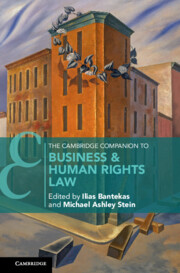Book contents
- The Cambridge Companion to Business & Human Rights Law
- Cambridge Companions to Law
- The Cambridge Companion to Business & Human Rights Law
- Copyright page
- Contents
- Figures and Tables
- Contributors
- Preface
- Cases
- Abbreviations
- 1 Business and Human Rights
- 2 Reconciling International Human Rights with International Trade
- 3 Neoliberalism, State-Capitalism and European Ordo-Liberalism
- 4 Corporate Governance and Corporate Social Responsibility
- 5 The Role of Business in International Development and the Attainment of the Sustainable Development Goals
- 6 The Business Case for Human Rights
- 7 The UN Guiding Principles on Business and Human Rights and Its Predecessors
- 8 The Regulatory Framework of Multinational Enterprises
- 9 The UN Global Compact and the OECD Guidelines for Multinational Enterprises and Their Enforcement Mechanisms
- 10 Taxation and Business
- 11 Corporate Accountability for the Natural Environment and Climate Change
- 12 Corporate Accountability for Corruption and the Business Case for Transparency
- 13 Disability, Business and Human Rights
- 14 Gender, Business and Human Rights
- 15 The Business Sector and the Rights to Work and Just and Favourable Conditions of Work
- 16 Responsible Lending
- 17 Business and Human Rights Approaches to Intellectual Property
- 18 The Role of Human Rights in Investment Law and Arbitration
- 19 The Use of International Arbitration Tribunals for Business and Human Rights Disputes
- 20 Innovative Contractual Remedies with Indigenous Peoples
- 21 The Role of Ethics in Corporate Human Rights Impact Assessments
- 22 Addressing Human Rights Impacts in Sustainability Reporting
- 23 Leveraging the Consumer-Led Movement to Strengthen Sustainable Business
- 24 The Structural Complexity of Multinational Corporations and the Effect on Managing Human Rights Risks in the Supply Chain
- 25 Towards a UN Business and Human Rights Treaty
- Index
17 - Business and Human Rights Approaches to Intellectual Property
Published online by Cambridge University Press: 10 September 2021
- The Cambridge Companion to Business & Human Rights Law
- Cambridge Companions to Law
- The Cambridge Companion to Business & Human Rights Law
- Copyright page
- Contents
- Figures and Tables
- Contributors
- Preface
- Cases
- Abbreviations
- 1 Business and Human Rights
- 2 Reconciling International Human Rights with International Trade
- 3 Neoliberalism, State-Capitalism and European Ordo-Liberalism
- 4 Corporate Governance and Corporate Social Responsibility
- 5 The Role of Business in International Development and the Attainment of the Sustainable Development Goals
- 6 The Business Case for Human Rights
- 7 The UN Guiding Principles on Business and Human Rights and Its Predecessors
- 8 The Regulatory Framework of Multinational Enterprises
- 9 The UN Global Compact and the OECD Guidelines for Multinational Enterprises and Their Enforcement Mechanisms
- 10 Taxation and Business
- 11 Corporate Accountability for the Natural Environment and Climate Change
- 12 Corporate Accountability for Corruption and the Business Case for Transparency
- 13 Disability, Business and Human Rights
- 14 Gender, Business and Human Rights
- 15 The Business Sector and the Rights to Work and Just and Favourable Conditions of Work
- 16 Responsible Lending
- 17 Business and Human Rights Approaches to Intellectual Property
- 18 The Role of Human Rights in Investment Law and Arbitration
- 19 The Use of International Arbitration Tribunals for Business and Human Rights Disputes
- 20 Innovative Contractual Remedies with Indigenous Peoples
- 21 The Role of Ethics in Corporate Human Rights Impact Assessments
- 22 Addressing Human Rights Impacts in Sustainability Reporting
- 23 Leveraging the Consumer-Led Movement to Strengthen Sustainable Business
- 24 The Structural Complexity of Multinational Corporations and the Effect on Managing Human Rights Risks in the Supply Chain
- 25 Towards a UN Business and Human Rights Treaty
- Index
Summary
The relationship between business activity and human rights in the context of intellectual property (IP) is unique. First, it is an example of how national efforts to control the human rights impact of business activities can be frustrated by international agreements. Thus, the obligation under the Guiding Principles for states to maintain sufficient national policy space to address human rights impacts is particularly important in this area. Corporations also have a responsibility not to push for changes in domestic and international law that would enable them to maximize profits at the expense of human rights. Second, the case of human rights and IP provides an example of corporations taking advantage of legal rules that allow them to extract profits at the expense of human rights. These legal rules are directed toward a legitimate purpose, but they can also be abused in ways that harm human rights. Thus, the relationship between IP and human rights demonstrates that corporations may have a responsibility not to take maximal advantage of opportunities to make a profit where doing so would violate human rights. It also indicates that human rights law may constrain states in the choices they make about how to incentivize innovation.
- Type
- Chapter
- Information
- The Cambridge Companion to Business and Human Rights Law , pp. 380 - 405Publisher: Cambridge University PressPrint publication year: 2021
- 1
- Cited by

